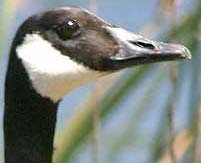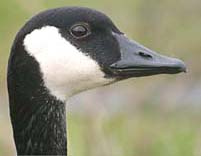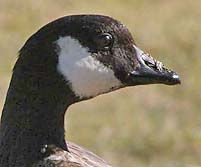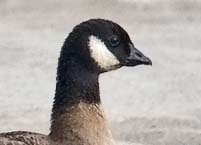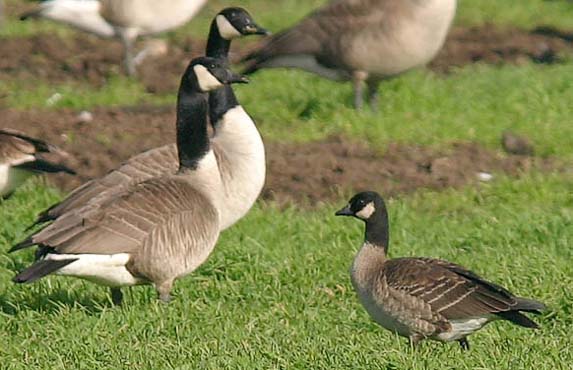 Canada Goose
Canada Goose
Branta canadensis
&
Cackling Goose
Branta hutchinsii
Page One
a web page by Don Roberson
Canada Goose (above left) & Cackling Goose (above right), Moonglow Dairy 16 Dec 2004 © Jeff Poklen |
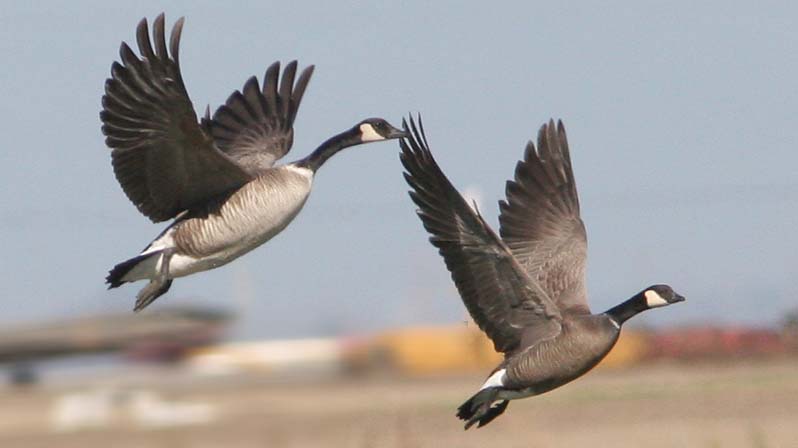 |
|||||||||||||
Lesser Canada Goose (left) & Ridgway's Cackling Goose (right) 17 Jan 2009 near Salinas © D. Roberson |
|||||||||||||
Here in coastal central California (including Monterey County) we don't usually have much trouble picking out a tiny Cackling Goose from among the huge resident population of Canada Goose. But things are more complex than that. There are two subspecies of Cackling Goose that occur as migrants and winter visitors — Aleutian Cackling Goose B. h. leucopareia and Ridgway's Cackling Goose B. h. minima — and there are migrant races of Canada Goose that are much smaller than our resident birds. Migrant Canada Goose can be much closer to the size of Cackling Goose (photo just above). Further, there are additional subspecies of both Canada and Cackling Geese that have not yet been confirmed for Monterey County, but that could occur in the future. We need to get a handle on all of them. In putting together this web page, I relied heavily on the identification criteria published by Mlodinow et al. (2008) and in the on-line sources cited at the end of this project. Mlodinow et al. (2008) coined the name Ridgway's Cackling Goose for the smallest subspecies of Cackling Goose, minima. It is the one subspecies that had no common English name. For purposes of this project, I'll use these names. listed from the largest to the smallest geese:
Note that the first four subspecies are assigned to Canada Goose, and the final three to Cackling Goose. |
|||||||||||||
Photo (right) 15 May 2008 El Estero, Monterey |
|||||||||||||
However, as they are not native, we are not sure how to assign these resident geese to subspecies. Moffitt's Canada Goose has been suspected to be the origin of many western resident goose population, but the bird shown (left) looks pretty much like Giant Canada Goose. It is possible that the origin of our local residents includes a mixture of subspecies. |
|||||||||||||
For example, this Moffitt's Canada Goose was at the tip of Pt. Pinos 21-23 Jan 2009. It was feeding on detritus washed up at tideline, and not interacting with pairs of resident birds flying by. Could this be a wild migrant? Maybe . . . or maybe not. There is no good way to know. It does have a demarcation between the bill and the steeper forehead, unlike some of our breeding birds, but so do others that nest here. We suspect that wild Moffitt's Canada Goose is our most common migrant, but it is now very hard to separate them from resident birds. This individual, though, did show the flexible neck possessed by these big geese (above right). |
|||||||||||||
| A small number of our migrant Canada Goose are of the interior Alaskan race parvipes, known as Lesser Canada Goose. These birds can be half the size of our resident Canada Geese. And other races may also occur. Most Lesser Canada Goose are pale-breasted but some can be quite dusky. | |||||||||||||
|
|||||||||||||
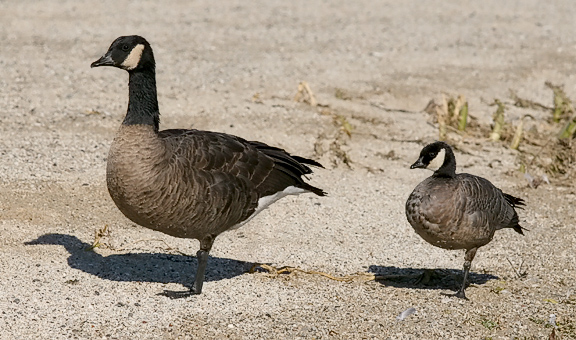 |
|||||||||||||
| The dark-breasted Dusky Canada Goose B.c. occidentalis has been recorded just north of us along the coast (photo below right). It is, however, a reasonably large Canada, as is obvious when it is next to a Ridgway's Cackling (above © Jeff Poklen, 18 Jan 2007 Halfmoon Bay). So size will be an important criteria in identifying the various races of these two species. More on that below; see also the very nice charts of comparative sizes (culmen length, mass) of all subspecies of both Canada & Cackling Geese in an on-line article by David Sibley [his commentary is only preliminary, but his charts are quite nice and derived from Mowbray et al. 2002]. | |||||||||||||
To clearly separate Canada from Cackling Geese we need to look at other characters, such as bill size and shape: |
|||||||||||||
|
|||||||||||||
| Size, bill shape, and breast color are important characters, and are best analyzed when there are various geese to compare. Here are six geese near Salinas on 21 Jan 2009. The three standing on dry ground are very large, with long bills and white breasts. They are either Moffitt's Canada Geese or a moffitti/maxima mixture, just like our resident birds. Standing in water are three decidedly smaller geese. The lefthand bird is very small and has a very dark breast; the next one is also very small but has a paler breast, and the third one (to the right of the first big goose on shore) is a bit larger and has even a paler breast. All three of the small geese of white neck collars of varying widths. | |||||||||||||
 |
|||||||||||||
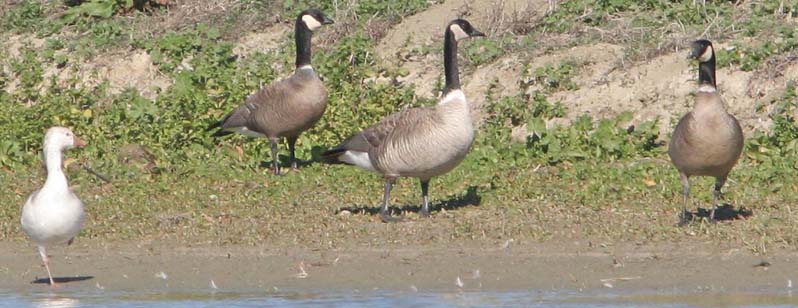 |
|||||||||||||
Let's look at the three small geese more closely (above), and compare with a Ross's Goose (extreme left). The lefthand dark goose is the size of Ross's, has a very dark, almost purplish-brown breast, and a very short triangular bill. It is Ridgway's Cackling Goose. The center dark goose is decidedly larger, has a bill that is obviously longer than deep, and is quite white-breasted. It is shown in flight next to the Ridgway's in the next to top shot on this page. I've shared these shots with Steven Mlodinow and Bruce Deuel, co-authors of Mlodinow et al. (2008), and they agree this center dark bird is most likely a Lesser Canada Goose B.c. parvipes. It is only half-the-size of the big Moffitt-like Canada Geese. This particular bird has a very broad white neck collar, which is unusual. Most parvipes don't have neck collars, but Deuel points out that a small percentage do (8% in the study by Johnson et al. 1979). The pale breast is typical of parvipes, so only the collar is unusual. This leaves the other small dark goose which is facing us (far right, above), so we can't see bill shape, but it is mid-size between the other two, has a medium-dark breast (not as dark as Ridgway's), and has a medium white neck ring. We can, however, evaluate it better in flight (below). The Lesser Canada is still in the center, and obviously the largest with the bigger bill. The tiny, very dark-breasted minima is now to the right, and the third mid-sized goose is now to the left. It clearly has a short bill but decidedly longer than minima, and it is decidedly larger. Our third dark goose is an Aleutian Cackling Goose. |
|||||||||||||
 |
|||||||||||||
 |
|||||||||||||
We can confirm this all again in another shot with Ross's Goose as a comparative (above). From left: Lesser Canada, Ross's, Aleutian Cackling, and Ridgway's Cackling. Note again the difference in bill shape in the two Cackler's. We'll get into more depth in separating between races of Cackling Geese in the second page of this project: |
|||||||||||||
Literature cited:
|
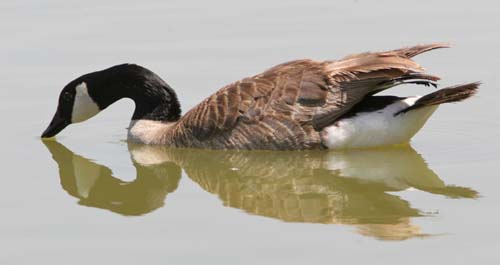 The
first step in understanding these white-cheeked geese is to be very
familiar with our local Canada Goose (right). Here in MTY, the nesting
Canada Geese are not native. They belong to
an introduced population that was first noticed in the 1980s, and that
has spread throughout the county. Hundreds now breed from Moss Landing
to Big Sur (see Roberson & Tenney 1993 for more details on this
expansion).
The
first step in understanding these white-cheeked geese is to be very
familiar with our local Canada Goose (right). Here in MTY, the nesting
Canada Geese are not native. They belong to
an introduced population that was first noticed in the 1980s, and that
has spread throughout the county. Hundreds now breed from Moss Landing
to Big Sur (see Roberson & Tenney 1993 for more details on this
expansion). 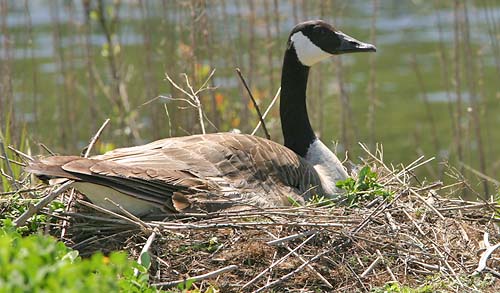 Some
of these nesting birds (left) are huge geese with long necks, a long
sloping forehead that continues its 'line' into the bill (recalling
Canvasback in shape), and whitish breasts. These look very much like
Giant Canada Goose.
Some
of these nesting birds (left) are huge geese with long necks, a long
sloping forehead that continues its 'line' into the bill (recalling
Canvasback in shape), and whitish breasts. These look very much like
Giant Canada Goose.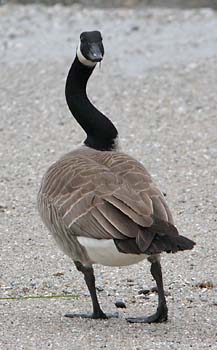
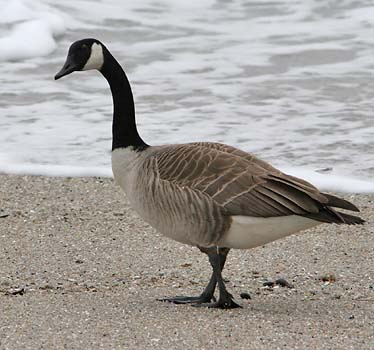 In
addition to our breeding population of Canada Goose, migrants from
northern or interior populations pass through during migration, and
some may winter. We know that flocks of several hundred have wintered
on Lake San Antonio, but it is now much more difficult to distinguish
between migrants and resident birds, because our residents are so
widespread.
In
addition to our breeding population of Canada Goose, migrants from
northern or interior populations pass through during migration, and
some may winter. We know that flocks of several hundred have wintered
on Lake San Antonio, but it is now much more difficult to distinguish
between migrants and resident birds, because our residents are so
widespread. 
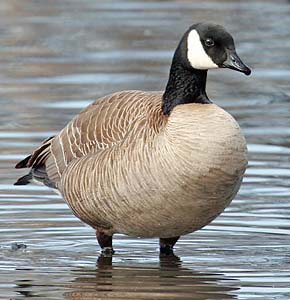

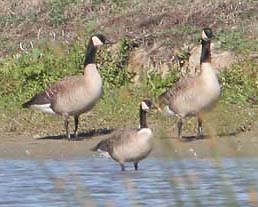 But
size is not enough. Through the magic of PhotoShop, I've moved a Lesser
Canada Goose to a spot between two of our resident Moffitt-like Canada
Goose (left). It looks really small between the two big geese. That
does not make it a Cackling Goose.
But
size is not enough. Through the magic of PhotoShop, I've moved a Lesser
Canada Goose to a spot between two of our resident Moffitt-like Canada
Goose (left). It looks really small between the two big geese. That
does not make it a Cackling Goose. 